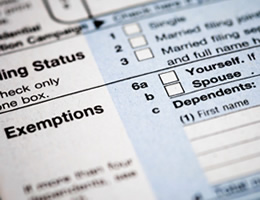The IRS recently agreed to extend the tax benefits available to traditional spouses to spouses of same-sex marriages following the Supreme Court case upholding the validity of these unions. But some couples continue to live as domestic partners without the formal legal trappings of a marriage. This raises a number of interesting questions.
For instance, under a particular employer’s benefits plans, a domestic partner may be eligible for health insurance coverage and certain other benefits, such as rights to pension plan payments. But can a spouse employed by the company claim a dependency exemption for a domestic partner? That takes us back to the rules for “qualifying relatives” written into the tax code.
For starters, each personal exemption you can claim for the 2016 tax year, including exemptions for dependents, is $4,050. (This figure remains the same in 2017.) Thus, if you have a total of four exemptions in 2016, you can reduce your tax bill by $16,200. In a 33% tax bracket, that’s worth $5,346.
The requirements for claiming a dependency exemption for a qualifying child are relatively easy to decipher. For instance, if you provide more than half of the support of a child under age 19, or a child who is a full-time student under age 24, you’re generally entitled to the exemption. But the rules for domestic partners are dicier.
Specifically, the following conditions must be met to claim the exemption:
- Your partner must be a U.S. citizen, national or resident alien or a resident of Canada or Mexico.
- Your partner must live with you the entire year.
- No other taxpayer (e.g. the domestic partner’s parents) can claim the partner as a dependent child on his or her tax return.
- Your partner can’t be married to someone else and file a joint return with that other person (except to claim a refund of withheld income tax or estimated income tax).
- You must provide more than half of your partner’s support during the year.
- Your partner’s gross taxable income for the year can’t exceed the personal exemption amount.
It’s the last requirement that often trips up taxpayers. Even if your domestic partner only works part-time during the year, it doesn’t take much to surpass $4,050 in gross taxable income. However, if you’re falling short due the requirement of providing more than half of your partner’s support, an extra contribution of support around the winter holidays could put you over the top.
Also, note that your domestic partner must reside with you the entire year, but certain temporary absences – such as vacations, business trips, hospital stays, or education-related or military absences – won’t count against you.
Finally, under current law, the tax benefit of personal exemptions is phased out for upper-income taxpayers. For 2016, the phase-out begins at $259,400 of modified adjusted gross income (MAGI) for single filers. (This threshold increases to $261,500 in 2017).
Changes to come? President-elect Trump has proposed a complete overhaul of the tax code and other reforms that could dramatically alter the landscape in the near future. For instance, he has vowed to repeal and replace Obamacare, which could impact health insurance benefits for domestic partners. In addition, Trump favors a repeal of personal exemptions in coordination with other sweeping tax law changes for individuals. We will continue to keep you updated on key developments.
Thanks for reading CPA Practice Advisor!
Subscribe Already registered? Log In
Need more information? Read the FAQs




